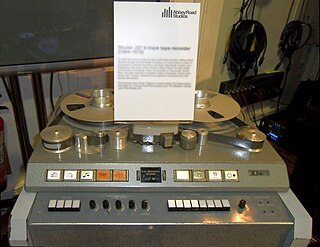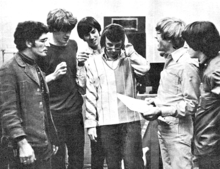
Digital music technology encompasses the use of digital instruments, computers, electronic effects units, software, or digital audio equipment by a performer, composer, sound engineer, DJ, or record producer to produce, perform or record music. The term refers to electronic devices, instruments, computer hardware, and software used in performance, playback, recording, composition, mixing, analysis, and editing of music.

A recording studio is a specialized facility for recording and mixing of instrumental or vocal musical performances, spoken words, and other sounds. They range in size from a small in-home project studio large enough to record a single singer-guitarist, to a large building with space for a full orchestra of 100 or more musicians. Ideally, both the recording and monitoring spaces are specially designed by an acoustician or audio engineer to achieve optimum acoustic properties.

Mastering, a form of audio post production, is the process of preparing and transferring recorded audio from a source containing the final mix to a data storage device, the source from which all copies will be produced. In recent years, digital masters have become usual, although analog masters—such as audio tapes—are still being used by the manufacturing industry, particularly by a few engineers who specialize in analog mastering.

Multitrack recording (MTR), also known as multitracking, is a method of sound recording developed in 1955 that allows for the separate recording of multiple sound sources or of sound sources recorded at different times to create a cohesive whole. Multitracking became possible in the mid-1950s when the idea of simultaneously recording different audio channels to separate discrete tracks on the same reel-to-reel tape was developed. A track was simply a different channel recorded to its own discrete area on the tape whereby their relative sequence of recorded events would be preserved, and playback would be simultaneous or synchronized.

Reel-to-reel audio tape recording, also called open-reel recording, is magnetic tape audio recording in which the recording tape is spooled between reels. To prepare for use, the supply reel containing the tape is placed on a spindle or hub. The end of the tape is manually pulled from the reel, threaded through mechanical guides and over a tape head assembly, and attached by friction to the hub of the second, initially empty takeup reel. Reel-to-reel systems use tape that is 1⁄4, 1⁄2, 1, or 2 inches wide, which normally moves at 3+3⁄4, 7+1⁄2, 15 or 30 inches per second. Domestic consumer machines almost always used 1⁄4 inch (6.35 mm) or narrower tape and many offered slower speeds such as 1+7⁄8 inches per second (4.762 cm/s). All standard tape speeds are derived as a binary submultiple of 30 inches per second.

A digital audio workstation is an electronic device or application software used for recording, editing and producing audio files. DAWs come in a wide variety of configurations from a single software program on a laptop, to an integrated stand-alone unit, all the way to a highly complex configuration of numerous components controlled by a central computer. Regardless of configuration, modern DAWs have a central interface that allows the user to alter and mix multiple recordings and tracks into a final produced piece.
Automatic double-tracking or artificial double-tracking (ADT) is an analogue recording technique designed to enhance the sound of voices or instruments during the mixing process. It uses tape delay to create a delayed copy of an audio signal which is then played back at slightly varying speed controlled by an oscillator and combined with the original. The effect is intended to simulate the sound of the natural doubling of voices or instruments achieved by double tracking. The technique was developed in 1966 by engineers at Abbey Road Studios in London at the request of the Beatles.
Overdubbing is a technique used in audio recording in which audio tracks that have been pre-recorded are then played back and monitored, while simultaneously recording new, doubled, or augmented tracks onto one or more available tracks of a digital audio workstation (DAW) or tape recorder. The overdub process can be repeated multiple times. This technique is often used with singers, as well as with instruments, or ensembles/orchestras. Overdubbing is typically done for the purpose of adding richness and complexity to the original recording. For example, if there are only one or two artists involved in the recording process, overdubbing can give the effect of sounding like many performers.

Sound recording and reproduction is the electrical, mechanical, electronic, or digital inscription and re-creation of sound waves, such as spoken voice, singing, instrumental music, or sound effects. The two main classes of sound recording technology are analog recording and digital recording.
Home recording is the practice of recording sound in a private home instead of a professional recording studio. A studio set up for home recording is called a home studio or project studio. Home recording is widely practiced by voice actors, narrators, singers, musicians, podcast hosts, and documentary makers at all levels of success. The cost of professional audio equipment has dropped steadily as technology advances during the 21st century, while information about recording techniques has become easily available online. These trends have resulted in an increase in the popularity of home recording and a shift in the recording industry toward recording in the home studio. The COVID-19 pandemic and COVID-19 lockdowns resulted in a dramatic global increase in the number of remote workers in 2020, which is anticipated by experts to remain a permanent shift in the field of sound recording when the pandemic ends.

Hip hop production is the creation of hip hop music in a recording studio. While the term encompasses all aspects of hip hop music creation, including recording the rapping of an MC, a turntablist or DJ providing a beat, playing samples and "scratching" using record players and the creation of a rhythmic backing track, using a drum machine or sequencer, it is most commonly used to refer to recording the instrumental, non-lyrical and non-vocal aspects of hip hop.
The history of sound recording - which has progressed in waves, driven by the invention and commercial introduction of new technologies — can be roughly divided into four main periods:

Multitrack recording of sound is the process in which sound and other electro-acoustic signals are captured on a recording medium such as magnetic tape, which is divided into two or more audio tracks that run parallel with each other. Because they are carried on the same medium, the tracks stay in perfect synchronization, while allowing multiple sound sources to be recorded at different times.
An audio signal is a representation of sound, typically using either a changing level of electrical voltage for analog signals, or a series of binary numbers for digital signals. Audio signals have frequencies in the audio frequency range of roughly 20 to 20,000 Hz, which corresponds to the lower and upper limits of human hearing. Audio signals may be synthesized directly, or may originate at a transducer such as a microphone, musical instrument pickup, phonograph cartridge, or tape head. Loudspeakers or headphones convert an electrical audio signal back into sound.

An audio engineer helps to produce a recording or a live performance, balancing and adjusting sound sources using equalization, dynamics processing and audio effects, mixing, reproduction, and reinforcement of sound. Audio engineers work on the "technical aspect of recording—the placing of microphones, pre-amp knobs, the setting of levels. The physical recording of any project is done by an engineer…"

In sound recording and reproduction, audio mixing is the process of optimizing and combining multitrack recordings into a final mono, stereo or surround sound product. In the process of combining the separate tracks, their relative levels are adjusted and balanced and various processes such as equalization and compression are commonly applied to individual tracks, groups of tracks, and the overall mix. In stereo and surround sound mixing, the placement of the tracks within the stereo field are adjusted and balanced. Audio mixing techniques and approaches vary widely and have a significant influence on the final product.
Clif Norrell is an American record producer, recording engineer, music mixer, and musician. He has worked with many prominent artists including Bruce Springsteen, R.E.M., Jeff Buckley, No Doubt, Rush, Faith No More, Shania Twain, Mick Jagger, Dave Grohl, Sting, Paul McCartney, Gavin Degraw, Joss Stone, Selena Gomez and The Police.

In music production, the recording studio is often treated as a musical instrument when it plays a significant role in the composition of music. Sometimes called "playing the studio", the approach is typically embodied by artists or producers who favor the creative use of studio technology in record production, as opposed to simply documenting live performances in studio. Techniques include the incorporation of non-musical sounds, overdubbing, tape edits, sound synthesis, audio signal processing, and combining segmented performances (takes) into a unified whole.

A bedroom producer is an amateur musician who creates, performs, and records their music independently using a home studio, often considered a hobbyist opposed to a professional record producer in the recording industry that works in a traditional studio with clients. Typically bedroom producers use accessible digital technology that costs less than the equipment in a professional studio, such as MIDI controller-based instruments and virtual studio technology, to create music for release to the world. While a professional record producer oversees and guides the recording process, often working alongside multiple people such as studio musicians, singers, engineers, mixers, songwriters, arrangers, and orchestrators, a bedroom producer does everything independently: creating the ideas, recording them and processing them for release. Bedroom producers are often self-taught, learning sound design, mixing and music theory by reading music production blogs and watching tutorials on the internet. As bedroom producers depend on the accessibility of music technology, bedroom production has been made easier with advances in home computing power and digital audio workstations (DAW).

Catharine Wood is an American composer, songwriter, musician, producer, audio engineer and studio owner associated with both popular music and music for picture. Her work is primarily influenced by folk, rock, pop and soul music. In addition to being a vocal activist for songwriters, Wood is recognized for her contributions as a recording arts leader and mentor by AES and NAMM presenting alongside Grammy winning Leslie Ann Jones and Lenise Bent. She has been highlighted in two UK published Routledge academic books as a trailblazer in the professional music engineering and producer community: “Women in Audio” and “Gender in Music Production” in Chapters 4 and 13 respectively. In 2022, Wood was elected to The Recording Academy Los Angeles Chapter Board of Governors.
















